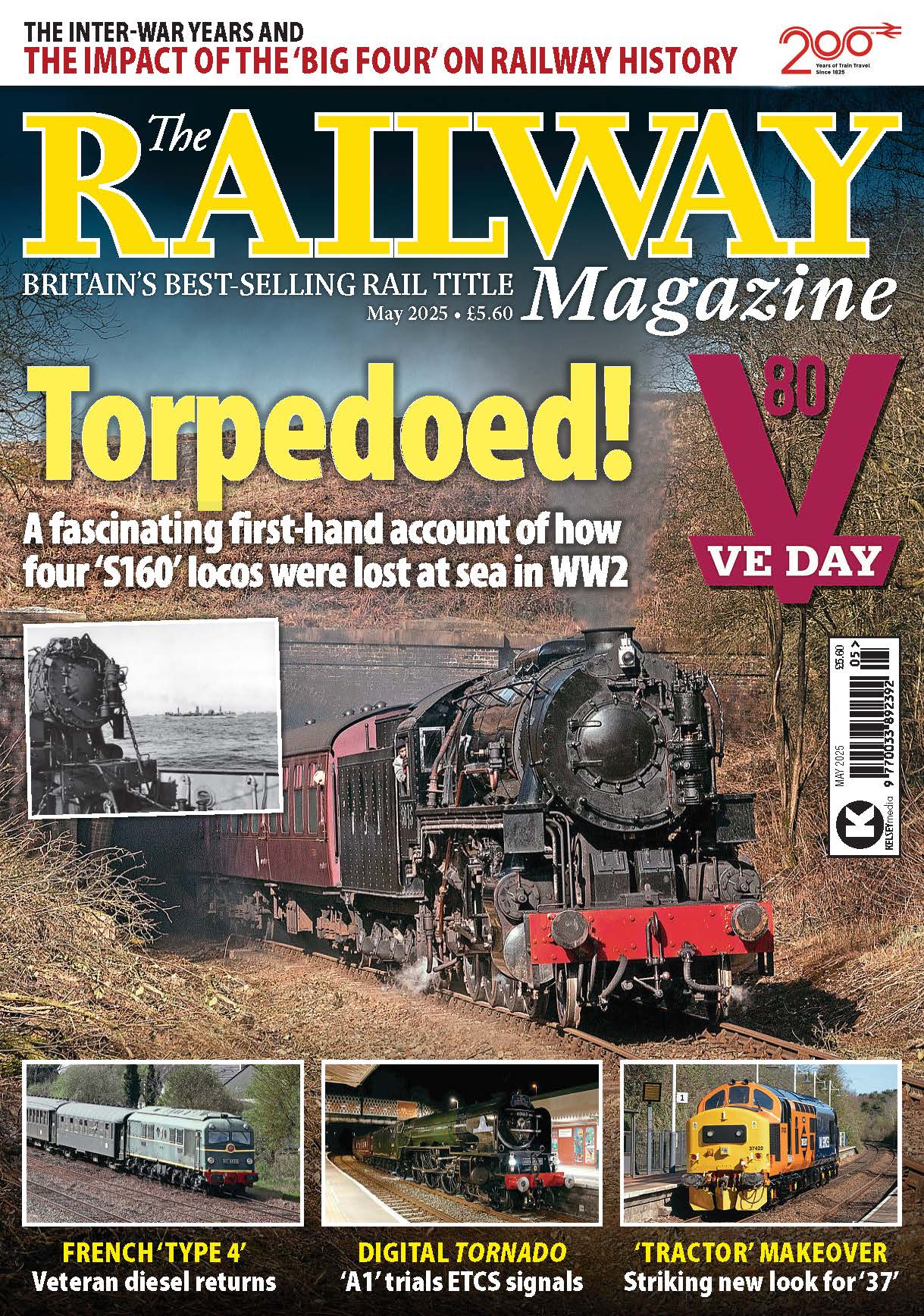

Running through some of the best scenery North Yorkshire offers, the Wensleydale Railway is a relative newcomer to the heritage and tourist railway sector. Graeme Pickering finds out more about its growth and expansion plans.
A train ride is undoubtedly the main highlight of a trip to a heritage line, but with railways increasingly trying to cater for greater visitor expectations, the journey itself is often just one aspect of the visit.
For the Wensleydale Railway (WR) in North Yorkshire, the next stage of enhancing that wider experience is the restoration of the station building at its Leeming Bar headquarters, for which it was awarded £368,000 from the Heritage Lottery Fund earlier this year.
Monthly Subscription: Enjoy more Railway Magazine reading each month with free delivery to you door, and access to over 100 years in the archive, all for just £5.35 per month.
Click here to subscribe & save
“People want more to do,” says Wensleydale Railway general manager Richard Brown. “They’re not just turning up at the train at the time of departure, they’re turning up half an hour earlier, they’re wanting to look around, they’re wanting to see things, they’re wanting to touch, be tactile with things. We’ve got to be able to start capturing people’s attention. I think this is in general for all heritage railways.
It’s about that experience of: ‘Oh yes, I got to do this and I got to pick that up, then we had a train ride’. It can’t be just about the train ride any more.”
Country station
The WR’s heritage education programme, which offers pupils up to 11 years old a school visit to the railway, is now into its fourth year. It is currently centred upon Scruton station, between Leeming Bar and Northallerton, which was fully restored from a derelict state in 2014.
With the help of volunteers dressed in period costume, the station and a collection of artefacts is used to cover several areas of the national curriculum through group activities based on life at a country station 100 years ago.
Richard adds: “At present we do a small schools’ engagement project, but we want to expand that, and by getting the grant for Leeming Bar that will enable us to enrich the experience for the kids that are going to come. They can see a station in one period, move down the line by train to a station in another period.
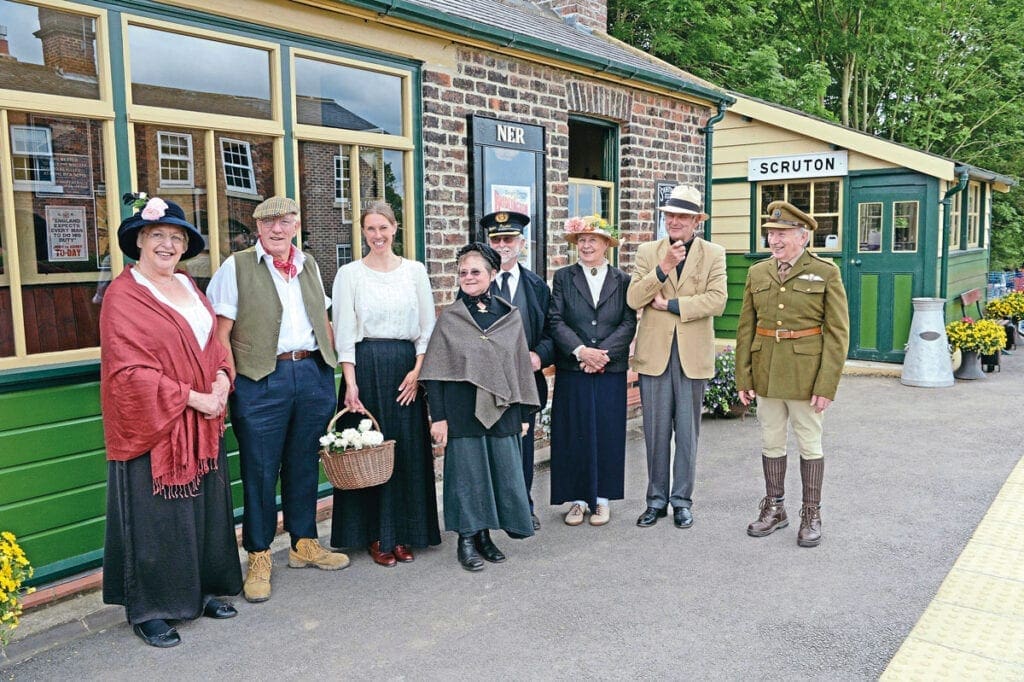
“They’re seeing a bit of difference so they can see how things used to be. It also means an awful lot more to us than that. It’s not just about just about solely education. It’s about starting to re-create an experience for other passengers who come. For instance, downstairs is all going to be changed back into how it was originally. We’ve managed to find the original drawings.
“The actual renovation work on the building is scheduled to start in January. I think the first phase is to replace the roof. We’ve got to do that reasonably quickly because we’ve got house martins. We can’t disturb them over the nesting season so have to do the work in the first couple of months of the year or towards the back end of the year. Once the roof’s done, it’s starting to look at the works internally. There’s quite a lot of work to do to take out some of the modern alterations that were done. When the building was sold it was split into two houses so there’s quite a lot of alteration to do to make it back into one building.
“It’ll have a ticket office, parcel office, waiting room, boardroom for kids to sit and learn around, the kitchen to go back to how it was, washroom, scullery. Upstairs will be a couple of small offices and they’ll have a small collection of artefacts which they will store up there rather than being spread all over the place as there is at present.”

Footbridge
He added: “It’s Grade II-listed. The architect was G T Andrews. There are restrictions, but as part of the process we’ve worked with the local authority, Hambleton, who are particularly proactive, it has to be said. They’re really, really helpful. What’s been decided and how it will be achieved has all been thought about. It’s now just a case of ‘right let’s get on with it and let’s get it done’. It’s probably going to be 18 months to two years by the time it’s finished. All being well it should be a fantastic new resource for the railway.”
Further west, at Leyburn station, progress is being made with infrastructure work, including the installation of an old Furness Railway signalbox (which originally controlled the sidings for the Vickers Gun Range on the Cumbrian Coast route) and the old footbridge from Brigg station in Lincolnshire, which is undergoing refurbishment prior to being brought to its new home.
A passing loop was constructed last year (the original loop and signalbox were removed by British Rail, having been retained until the early 1980s). Mr Brown says a full-length second platform is planned too: “We’ve got to the stage of a signalbox, bridge and a small viewing platform, but the idea is that will act as a seed to grow the platform to a proper full-sized platform eventually. At that point we’ll be able to pass trains and stop trains and people will be able to swap over and do all sorts of other passenger-like things.
“Again it’s starting to move that line from what was a 22-mile siding to something that’s actually useable. We’ve had a loop at Constable Burton I think ever since the railway opened, but the problem is it’s in the middle of nowhere and there’s no station so it’s just a bit of a strange place to pass really because nobody can do anything. If you are stuck waiting for the other train you just have to sit there.
“The bridge is currently at a fabricators being repaired, checked over, new steelwork put in as necessary, so work is progressing. I think ideally we’d be looking either the end of this year or early next year towards finishing it. There’s still a little bit more fundraising to do towards it to finish it off but the bulk of the money is there. It’s now just about getting the work progressed and getting it installed. It’s visual interest more than anything. Who doesn’t like standing on top of a bridge when a steam engine goes underneath it and getting covered in soot?”
The work at Leyburn and securing funding for the building restoration at Leeming Bar are both major steps in the WR’s plans to make the most of the line’s potential as a heritage attraction rather than an operator of community rail services.
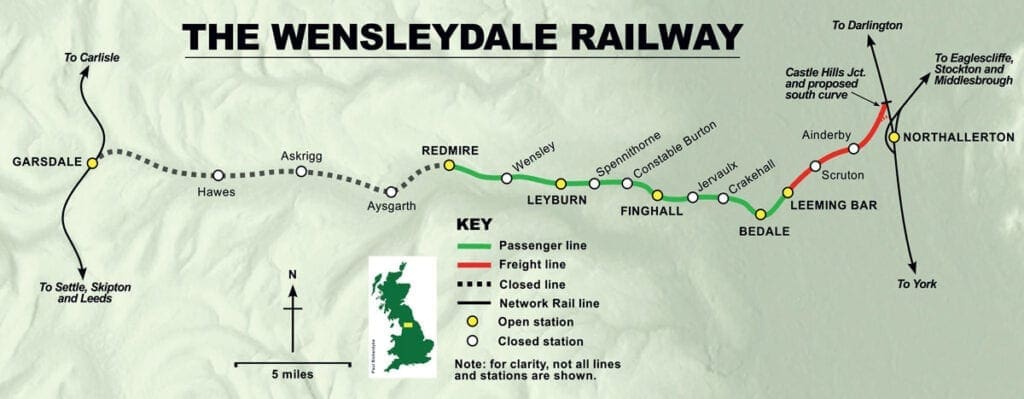
Community railway
“The one thing that I think we’ve go to bear in mind is that actually we’re still a community railway,” Richard points out.
“We work for the community, not necessarily as transport, but doing other things to bring people into the surrounding area, and that’s where we want to be, especially for Wensleydale itself. It’s quite a short tourist season so being able to bring in more and more people starts to help those local businesses because at the end of the day in a dale such as this there are two forms of industry: agriculture and tourism. It starts that stepping stone to be able to attract more passengers in and then to be able to distribute them out into the dale into other businesses and things like that.”
It’s a change of policy which hasn’t been without controversy, however. In making the decision to concentrate on its current operations, the WR decided to sell Aysgarth station, close to the popular visitor attraction of Aysgarth Falls. Three miles beyond its western terminus of Redmire, it sits on the derelict section of the old ‘through’ Wensleydale route, which once ran via Hawes, connecting to the Settle & Carlisle line at Garsdale.
The sale, to West Coast Railways’ David Smith, was viewed by some WR supporters as not only posing a serious threat to eventual hopes of trains returning to the head of the dale, but also to the less ambitious prospect of providing an alternative to travelling to Aysgarth by car.
The station had been valued at around £400,000. Part of the proceeds from the sale were used to pay off the mortgage, with the rest of the money being invested back into the railway.

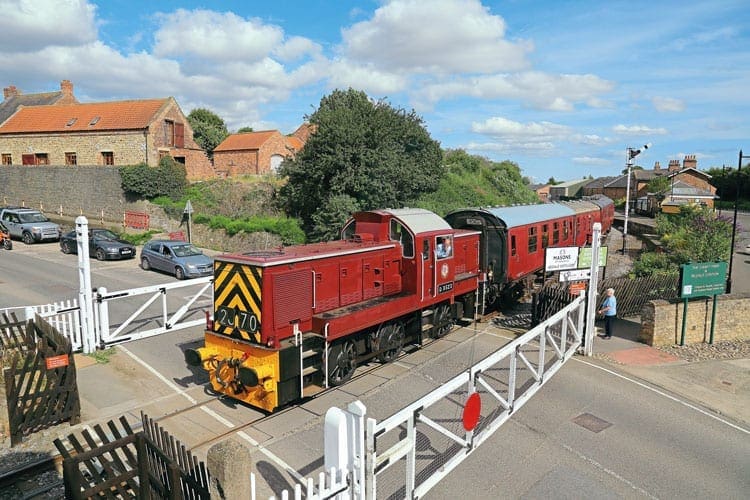
Sustainable
Richard says even in the condition it was sold in, the station was costing the WR £21,000 a year: “The fabric of the building was deteriorating. We couldn’t see anything in the short term that we could do that would improve the fabric and to find the money to invest in it to actually make it viable. I think that’s quite a hard thing to get over to people because it was such a sort of status goal for the Wensleydale Railway to get to Aysgarth. This will be controversial but I think it was the right thing for the railway to do. I think we would have struggled to continue to try to keep it going anyway. It’s paid for some very nice things that have helped the railway in the medium term.
“The railway wouldn’t have gone under but it would have eventually dragged the railway down because we couldn’t afford to keep maintaining the fabric. To be honest it would have been sad to see a building such as that just deteriorate.
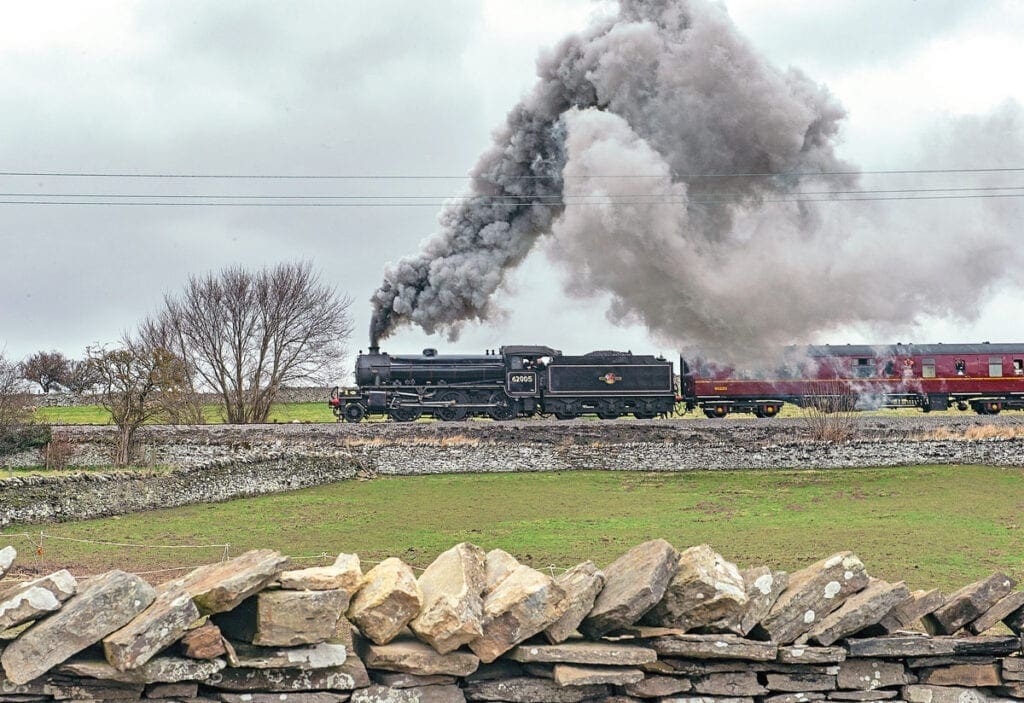
“In the greater scheme of things, yes, it would be lovely to extend and yes it’s not a dead ambition by any means but as operations manager previously I would question the sanity of adding another four miles of track onto 22 miles of track that requires a lot of work already. It’s just more track to look after, more money to spend and you’ve got to increase the passenger numbers proportionally to pay for that.
“It’s all about getting the railway to a sustainable future. There’s no point in having all the nice things and then finding the railway just collapses and falls in like a house of cards. That’s where the railway’s goals lie – to make itself sustainable.”
Another move which he hopes will help achieve that is a reduction of timetabled services this year: “By starting to concentrate on a couple of services a day and fewer services during the week you can start making a little bit more revenue out of those services you are running.
“One of the things that was quite interesting last year from my point of view was to look at some of the passenger data during August. I think everybody had thought Saturdays and Sundays are when everybody comes, but actually it turns out Tuesdays and Wednesdays spiked, Thursdays were very flat and then it went up Friday, Saturday and then dropped again on Sunday.
“We’ve now dropped Thursday as a running day because this pattern was continual, you could see it over three or four years that Thursdays for whatever reason were very, very poor. There’s no point trying to run something if you can see there’s a pattern where people don’t want to travel that day. If we’re running steam through that period that will save us the best part of £5,000 to £6,000 not running on the Thursday.”
The WR has at times in the past run timetabled services along the whole of the line which it leases from Network Rail, but for the past few years it has returned to just operating regular services along the western section between Leeming Bar and Redmire.
The 22-mile branch runs from its connection with the rail network at Castle Hills in Northallerton to sidings just beyond Redmire station, where until 1992 trains were loaded with locally quarried limestone for use in steel-making. Remarkably, this traffic outlasted freight on the rest of the line (which had all been lifted by the late 1960s) by almost 30 years, and its survival was further prolonged by the Ministry of Defence who installed facilities at Redmire in order to transport military vehicles by train.
The most recent of these movements, operated by GB Railfreight in January and March 2019, were the first since 2015, but more trains of this type are expected.
At its current level, Richard says the financial benefit of the traffic isn’t hugely significant: “It doesn’t bring a lot of money in and I think that’s one of the things that people maybe don’t quite understand. We’re obliged by our lease obligation to ensure that train is fit to run so we have to try to maintain our infrastructure to accept those trains. It wouldn’t be so bad if it was four miles, but 22 miles is a lot of infrastructure to maintain to keep trains running up and down. If there was one every day then it would be different. You’d be able to make some money out of them, but it’s so sporadic you couldn’t pin your hat on it. It’s a by-product of the lease rather than anything else.”
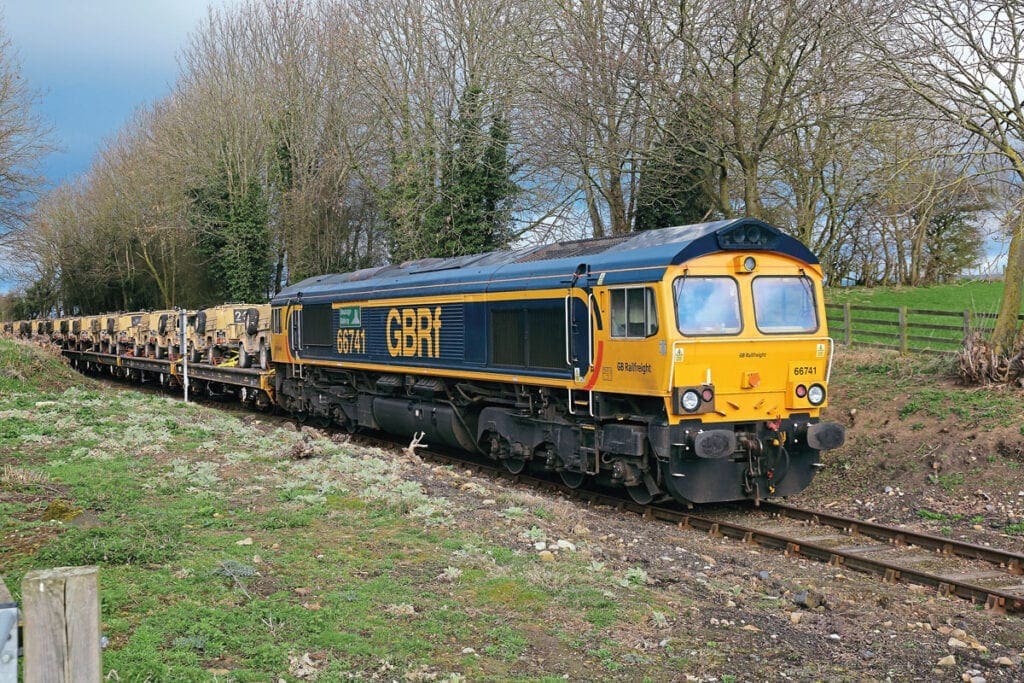
Wensleydale Railway upgrades
Leaseholder responsibilities have weighed heavy on the WR. So far, £100,000 has been spent on upgrading the line’s automatic crossings following a collision involving a train and a car at Yafforth in August 2016.
The Rail Accident Investigation Branch concluded that the crossing was “almost certainly” operating correctly, but the decision was taken to fit all three such crossings on the line with LED warning lights for road users, which are brighter than the traditional tungsten bulbs and comply with the latest standards.
Two of the three, Aiskew and Yafforth, have so far been upgraded. Options for the complete replacement of the third crossing, Ham Hall, near Scruton, are being investigated. It is of an experimental design, which is understood to date back to the mid-1970s.
The cost of unexpected repairs has also been substantial. After heavy rainfall in 2013, the trackbed at Akebar, between Bedale and Leyburn, was undermined by two major landslips. Repairs cost around £120,000.
Frustratingly, the second led to the line being closed for several months and came after remedial work on the first for which a special fundraising weekend had been held. The WR had even appealed via the media for visitors to come along and support it, offering free train rides over an unaffected section of the railway.
Richard Brown is in no doubt the WR has become more widely known since then: “We’re certainly more visible than we were five or six years ago. I think if you were to ask any general manager I’m sure they’d all say we’d rather be much more visible.
“I would much rather be having 100,000 passengers than 35,000 passengers, but there again it’s a process of growing the railway. The more attractive the railway becomes to visit the more people will come. That again links back to the Heritage Lottery funding.
“It’s starting to build something of interest to your stations as well – becoming more than just a train ride. I don’t think it’s about competing with any of the other railways. I think actually there’s probably enough tourists to go round for all of them one way or another. All railways have their own distinct character. They all have different scenery, all have different aspects, they all concentrate on different things.
“We’re seeing more and more come in and we’re actually less reliant on coach parties than we were three or four years ago. We’d like many more and part of that is the visibility.
“One of the challenges is how to do that on a very limited budget. We don’t have the budget some of the big railways have. We have to try to get as much publicity as we can for as little money as possible.”
“That is a challenge,” acknowledges the WR’s marketing manager Rebekah Jerram, who explains that building interest in the railway through online means such as Facebook has been significant in raising its profile.
“We are very lucky that we have a very large social media following. I think it’s just keeping that up-to-date, keeping our followers interested with what we’re doing, what we’re posting.
“We have just hit over 10,000 followers and this time last year we were on about 7,300 so that’s not bad for a little heritage railway. It’s just playing with the tools that we’ve got that are free. It’s encouraging our followers who are very passionate about the railway and want to see us succeed to help us by sharing and liking, which is absolutely brilliant.”
Non-stop steam
The visit of the A1 Steam Locomotive Trust’s No. 60163 Tornado in February provided a major social media opportunity thanks to the flypast of three RAF Tornados above the locomotive as part their farewell tour of the UK. The resulting video footage went viral and was watched by more than 100,000 people.
Of course it is translating at least some of that interest into actual visits to the line which is the bigger task. From May 18 to June 4, No. 60163 returned for a further 12 days in service at the railway, with special events, including hauling the first non-stop steam journey over the line since it reopened under WR operation in 2003.
Rebekah says special events are helping the railway to broaden its appeal: “I think you can tap a different market with the events, and it can bring people in that wouldn’t necessarily just come for a train ride, but once they visit us they discover more about us and then that could lead to them coming back.”
“I always like to think of events as the cream on top,” adds Richard. “You want your big events to make that extra revenue that over time you can then start investing into increasing events.
“Eventually, the events themselves should be able to help provide things like new track, new sheds rather than just continually ploughing it straight back into keeping the railway going.
“Your day-to-day running just keeps things ticking over, pays for your fuel costs, your building costs.
That’s a goal that we would aim to look at.”

ATTENTION! This Father’s Day, get an extra £5 off when you buy your father something he’ll really appreciate. Take out a gift subscription for any of the following titles and we’ll give you an extra £5 off… making it even cheaper for you to spoil him this Father’s Day. Click here to see some fantastic offers on subscriptions!





